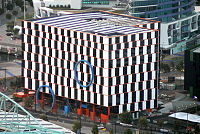
Café wall illusion
Encyclopedia

Parallel (geometry)
Parallelism is a term in geometry and in everyday life that refers to a property in Euclidean space of two or more lines or planes, or a combination of these. The assumed existence and properties of parallel lines are the basis of Euclid's parallel postulate. Two lines in a plane that do not...
straight dividing lines between staggered rows with alternating black and white "bricks" appear to be sloped.
It was first described under the name Kindergarten illusion, and re-discovered by Richard Gregory
Richard Gregory
Richard Langton Gregory, CBE, MA, D.Sc., FRSE, FRS was a British psychologist and Emeritus Professor of Neuropsychology at the University of Bristol.-Life and career:...
in 1973. According to Gregory, this effect was observed by a member of his laboratory, Steve Simpson, in the tiles of the wall of a café at the bottom of St Michael's Hill, Bristol
Bristol
Bristol is a city, unitary authority area and ceremonial county in South West England, with an estimated population of 433,100 for the unitary authority in 2009, and a surrounding Larger Urban Zone with an estimated 1,070,000 residents in 2007...
. It is a variant of the shifted-chessboard illusion originated by Münsterberg
Hugo Münsterberg
Hugo Münsterberg was a German-American psychologist. He was one of the pioneers in applied psychology, extending his research and theories to Industrial/Organizational , legal, medical, clinical, educational and business settings. Münsterberg encountered immense turmoil with the outbreak of the...
.
In the construction of the optical illusion
Optical illusion
An optical illusion is characterized by visually perceived images that differ from objective reality. The information gathered by the eye is processed in the brain to give a perception that does not tally with a physical measurement of the stimulus source...
often each "brick" is surrounded by a layer of "mortar" intermediate between the dark and light colours of the "bricks".
In the first and quite successful attempt at its deconstruction the illusion was ascribed largely to irradiation
Irradiation
Irradiation is the process by which an object is exposed to radiation. The exposure can originate from various sources, including natural sources. Most frequently the term refers to ionizing radiation, and to a level of radiation that will serve a specific purpose, rather than radiation exposure to...
, the light spread from dark to bright zones in the retinal image, and indeed the image disappears when black and white are replaced by different colours of the same brightness (isoluminant). But a component of the illusion remains even when all optical and retinal components are factored out.

External links
- Interactive version of the Café wall illusion (Requires Shockwave browser plugin)
- An animated "proof" that the horizontal lines are parallel and straight (This gif should open In most browsers)
- The original Café in Bristol on street view

